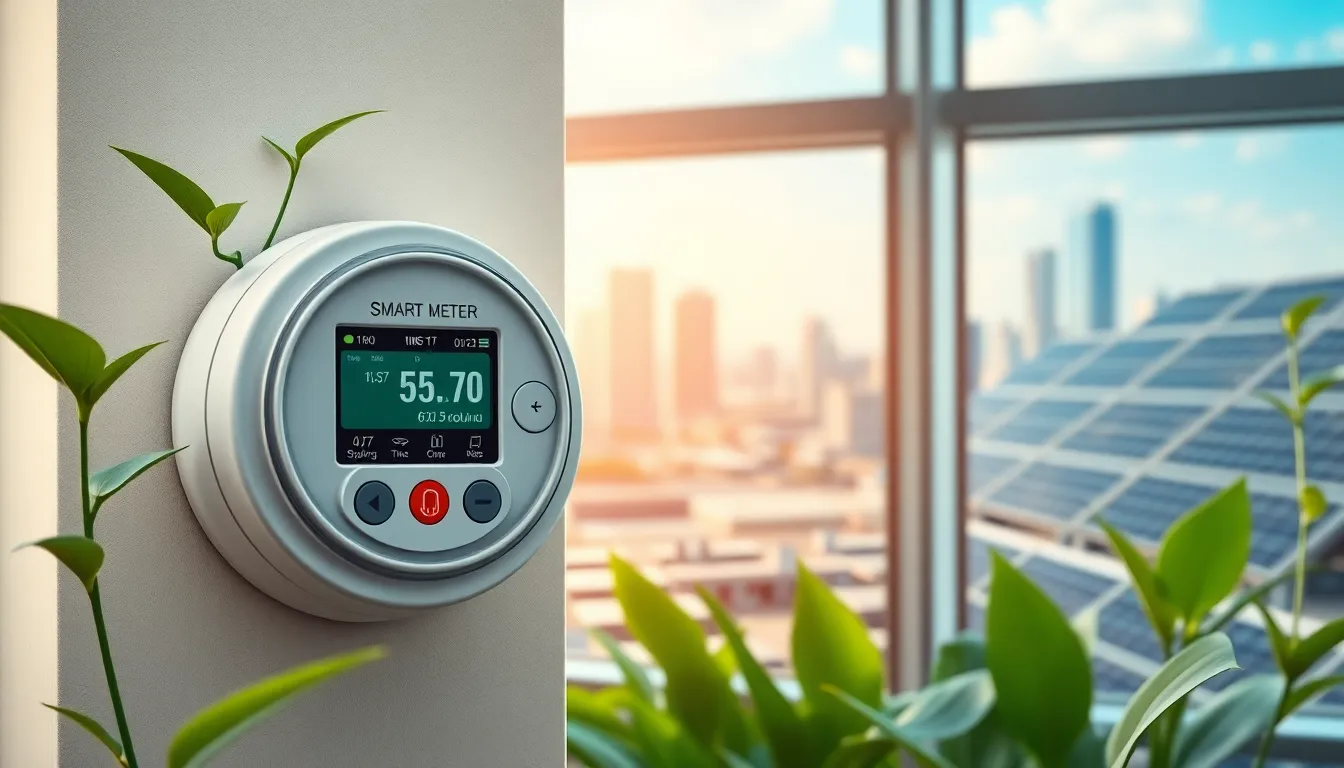In a world increasingly driven by technology, the intersection of sustainability and innovation has never been more critical. Green IoT, or the integration of eco-friendly practices within the Internet of Things, is paving the way for smarter and greener solutions. This emerging field not only enhances efficiency but also significantly reduces environmental impact, making it a vital focus for industries worldwide.
As businesses strive to meet sustainability goals, Green IoT offers practical applications that can transform energy consumption, waste management, and resource allocation. By leveraging connected devices and data analytics, organizations can optimize their operations while contributing to a healthier planet. Understanding how Green IoT works and its potential benefits can empower individuals and companies alike to embrace a more sustainable future.
Table of Contents
ToggleOverview of Green IoT
Green IoT merges sustainability with technology, focusing on reducing environmental impact through connected devices. This approach allows organizations to gather real-time data, optimizing operations across various sectors.
Efficient energy consumption stands as a primary goal of Green IoT. Organizations utilize smart meters and energy management systems to monitor and reduce usage. These measures can decrease energy bills and lower carbon footprints.
Waste management also benefits from Green IoT. Connected sensors in waste bins alert management when capacity reaches critical levels. This system minimizes unnecessary collection trips, reducing fuel consumption and emissions.
Resource allocation improves significantly as well. Smart irrigation systems, for example, adjust water usage based on soil moisture data. This technology conserves water and supports sustainable agriculture practices.
Incorporating renewable energy sources plays a vital role in Green IoT strategies. Solar panels and wind turbines can connect to IoT networks, allowing real-time monitoring and optimization of energy generation. This integration supports a transition to cleaner energy.
The application of Green IoT extends beyond enterprises. Homes equipped with smart thermostats and energy-efficient appliances support consumers in reducing their ecological footprint. Through improved efficiency, Green IoT fosters a culture of sustainability at every level.
Understanding Green IoT’s potential underscores its importance in achieving broader sustainability goals. As businesses and individuals commit to environmentally responsible practices, Green IoT presents a pathway toward a healthier planet.
Benefits of Green IoT

Green IoT offers numerous advantages that contribute significantly to sustainability efforts. Enhanced energy efficiency and reduced carbon footprints represent two primary benefits.
Energy Efficiency
Green IoT drives energy efficiency through the deployment of smart devices and systems. Smart meters allow organizations to monitor real-time energy usage, leading to informed decisions about consumption. For example, energy management systems track usage patterns, enabling businesses to identify and eliminate wasteful practices. Additionally, connected devices facilitate automated controls, such as adjusting lighting and heating based on occupancy, further optimizing energy consumption. According to the U.S. Department of Energy, energy efficiency improvements can reduce energy consumption by up to 30% in some commercial buildings.
Reduced Carbon Footprint
Green IoT contributes to a significant reduction in carbon footprints by minimizing energy waste and optimizing resource use. Integration of renewable energy sources within IoT frameworks enables real-time adjustment of energy loads, enhancing the efficiency of energy generation. For instance, solar energy systems can be monitored and managed to ensure optimal output and usage. Furthermore, efficient waste management practices, such as smart sensors in waste bins that notify collection services only when full, reduce unnecessary vehicle trips, lowering greenhouse gas emissions. A study by the International Energy Agency highlights that smart waste management can cut emissions by up to 20% in urban areas.
Key Technologies in Green IoT
Green IoT relies on advanced technologies that enhance sustainability and operational efficiency. Key components include smart sensors and data analytics, which play crucial roles in optimizing environmental management.
Smart Sensors
Smart sensors serve as the backbone of Green IoT by providing real-time data collection. These devices monitor environmental conditions, energy use, and resource levels. For instance, smart thermostats analyze temperature patterns to optimize heating and cooling in buildings, potentially reducing energy consumption by 10%-20%. Additionally, connected sensors in waste bins indicate fill levels, allowing for efficient collection schedules that minimize greenhouse gas emissions. Smart irrigation systems utilize soil moisture sensors to ensure precise water usage, reducing waste and promoting sustainable agricultural practices.
Data Analytics
Data analytics processes vast amounts of information generated by smart sensors, enabling informed decision-making. Analyzing energy consumption patterns allows organizations to identify areas for efficiency improvements, potentially lowering energy costs by up to 30%. Predictive analytics can forecast energy needs based on historical data, enhancing resource allocation. Furthermore, data analytics aids in assessing the effectiveness of sustainability initiatives, helping organizations measure their impact on carbon footprints and other environmental metrics. By leveraging data insights, businesses can refine operations, contribute to environmental sustainability, and achieve their sustainability goals more effectively.
Applications of Green IoT
Green IoT applications play a crucial role in enhancing sustainability across various sectors. They contribute significantly to smart cities and sustainable agriculture.
Smart Cities
Smart cities leverage Green IoT to improve urban living conditions and reduce environmental impact. Connected devices monitor traffic flow, optimize public transportation routes, and enhance waste management. For instance, smart traffic lights adapt in real-time to traffic conditions, reducing congestion and emissions. Smart waste bins equipped with sensors notify collection services when they reach capacity, minimizing unnecessary collection trips and lowering carbon footprints. Additionally, smart street lighting systems adjust brightness based on surrounding light conditions, leading to energy savings of up to 40%.
Sustainable Agriculture
Sustainable agriculture benefits greatly from Green IoT technologies, promoting efficient resource use and reducing waste. Smart irrigation systems utilize soil moisture data to optimize water consumption, conserving water while maintaining crop health. Data from connected sensors can also indicate nutrient levels and environmental conditions, enabling farmers to make informed decisions. Such precision agriculture methods have shown potential to increase crop yields by up to 20% while significantly reducing water and fertilizer usage. Integrating these IoT solutions fosters resilience in agricultural practices, supporting food security and environmental sustainability.
Challenges in Implementing Green IoT
Green IoT faces several challenges that can hinder its effective implementation. These challenges include infrastructure limitations and cost barriers, which organizations must navigate to achieve sustainable practices.
Infrastructure Limitations
Infrastructure limitations pose significant challenges for the deployment of Green IoT technologies. Many existing networks lack the necessary capabilities to support advanced IoT devices and systems. Older systems may require upgrades or replacements to enable seamless integration and real-time data exchange. For instance, rural areas often lack reliable internet connectivity, hampering the use of connected devices for monitoring and resource management. Furthermore, insufficient energy management frameworks can hinder the adoption of smart grids essential for renewable energy integration. Without appropriate infrastructure, organizations can’t fully realize the potential benefits of Green IoT.
Cost Barriers
Cost barriers significantly impact the adoption of Green IoT solutions. Initial investments in IoT devices, sensors, and systems can be substantial, posing challenges for small and medium-sized enterprises. While the long-term savings from improved efficiency may offset these costs, many organizations struggle to justify the upfront expenditures. Additionally, ongoing maintenance and operational costs continue to pose financial concerns, especially when budgets are limited. Organizations need to weigh the benefits against these costs and consider potential financing options to ensure that Green IoT projects achieve their intended sustainability goals.
Green IoT stands at the forefront of the movement toward a more sustainable future. By integrating smart technologies with eco-friendly practices, it empowers organizations to significantly reduce their environmental impact while enhancing operational efficiency.
The potential for energy savings and optimized resource management is immense. As businesses increasingly adopt these innovative solutions, they not only contribute to a healthier planet but also position themselves as leaders in sustainability.
Navigating the challenges of implementation will be crucial for maximizing the benefits of Green IoT. With commitment and investment, the transition to greener practices can pave the way for a smarter and more sustainable world.


